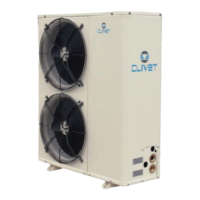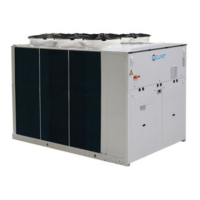
Do you have a question about the CLIVET WSAN-XPR Series and is the answer not in the manual?
Details the serial number label and its contents, including unit type, serial number, year of manufacture, and technical data.
Explains the importance of the serial number for unique machine identification and tracing specific features and components.
Explains the summer and winter operating cycles of the heat pump, detailing the refrigerant flow and heat transfer process.
Describes the components and flow within the unit's water circuit, including heating integration and hot water storage.
Covers essential instructions, manual storage, expert personnel, power supply, maintenance, and repair precautions for safe operation.
Identifies potential hazards such as electrical risks, handling, installation, and environmental dangers requiring specific precautions.
Instructions for checking the unit upon delivery, safe handling, lifting, and proper storage to maintain integrity.
Key considerations for siting the unit, including technical spaces, functional clearances, and anchoring.
Guidelines for piping design, intercepting valves, insulation, and preventing freeze risks in the water circuit.
Illustrates recommended use side connections and system schemas, including winter condensation management.
Requirements for personnel, power supply conformity, wiring practices, and unit electrical data.
Overview of the system's modules, including optional components like user ambient terminals and remote keypads.
Essential checks for unit installation, electrical supply, refrigerant, and water systems before operation.
Checking tensions, absorptions, and key refrigerant circuit parameters for optimal performance.
Description of operating modes (Cooling, Heating, ECO) and how thermoregulation is based on outlet temperature.
Details on set-point compensations, corrections, and adjustments for operating limits and efficiency.
Functions, buttons, LEDs, and signals related to the user remote keypad for unit control.
Instructions for setting the unit to Cooling, Heating, or Maintenance modes via the keypad.
Lists different alarm types (Electrical, Refrigerant, Water) and general procedures for alarm identification and reset.
Information on how to access and interpret the unit's status displayed on the remote or service keyboard.
Comprehensive list of alarm codes, their descriptions, and reset types (Auto/Manual) for diagnosing issues.
Identifies causes and solutions for common faults like high/low pressure, faulty probes, and protection system issues.
Procedures for cleaning and inspecting the external air coil, water exchanger, structure, and electric fans.
Procedures for safely disconnecting the unit, recovering refrigerant and antifreeze, and proper disposal.
Detailed physical dimensions, weight specifications, and minimum clearances required for various unit sizes.
Tables detailing cooling/heating performance, compressor specs, exchanger details, electrical data, and noise levels.
Graphical representation of the unit's operating limits for cooling and heating modes based on temperature conditions.
Factors for antifreeze solutions, fouling, pump performance curves, pressure drops, and sound level specifications.











